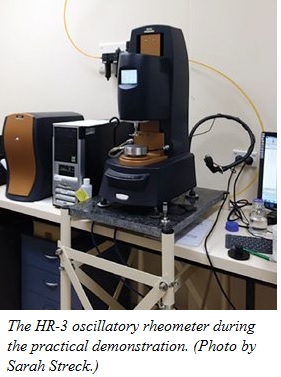Rheology: How to Get into the Flow
 November 24, 2015, was a day of rheology at the School of Pharmacy, University of Otago, Dunedin, when the invited speakers and 35 participants came together for the combined workshop of the New Zealand and Australian CRS chapters, “Pharmaceutical Rheology—Principles and Applications.” With this workshop we entered the world of rheology and got information, ideas, and advice to find our own way through the complexity of the topic.
November 24, 2015, was a day of rheology at the School of Pharmacy, University of Otago, Dunedin, when the invited speakers and 35 participants came together for the combined workshop of the New Zealand and Australian CRS chapters, “Pharmaceutical Rheology—Principles and Applications.” With this workshop we entered the world of rheology and got information, ideas, and advice to find our own way through the complexity of the topic.
Rheology describes the flow of a wide range of materials and accompanies us through the day, every day. In the morning we first get in contact with the flow of materials when we enter the bathroom and use shower gel, shampoo, and toothpaste. Later at work we continue with gels, polymers, and excipients, and finally rheology finds its glorious ending when we add ketchup to our fries for dinner.
Ph.D. students Sharan Bobbala and Sasi Bhushan Yarragudi welcomed all the invited speakers and participants from the University of Otago and the University of Auckland. Greg Walker (University of Otago), the vice president of NZCRS, opened the workshop, explaining the meeting was dedicated to everyone getting a better understanding of rheology.
The first speaker was Stefania Baldurdottir (University of Copenhagen, Denmark). After her long travel from Europe to New Zealand, she polished up our knowledge about rheology and highlighted some important basic rules and how to deal with them in the lab. In her talk she also shed light on the analysis and logical interpretation of data obtained from rheology studies.
Our next speaker, Natalie Medlicott (School of Pharmacy, University of Otago) focused on the pharmaceutical application of rheology, and her target site was the “periodontal pocket as a consequence of periodontal disease,” as well as the investigation of salvia. She emphasized the importance of rheology and its measurements in development of a successful pharmaceutical formulation.
The lunch break with a variety of good food was the first opportunity for participants and speakers to discuss the first talks of the day.
 Patrick Spicer (University of New South Wales, Australia) was the first speaker in the second session. In his passionate talk, “Microstructure and Rheology of Complex Fluids,” he focused on application of rheology measurements to interpret microstructure and the challenges with small volume rheology. He also gave us a lot of daily examples and provided tips for hair care.
Patrick Spicer (University of New South Wales, Australia) was the first speaker in the second session. In his passionate talk, “Microstructure and Rheology of Complex Fluids,” he focused on application of rheology measurements to interpret microstructure and the challenges with small volume rheology. He also gave us a lot of daily examples and provided tips for hair care.
The next speaker, Steve Moratti (Department of Chemistry,  University of Otago), explained the importance of rheology measurements to measure properties of gels and how gels can be used in surgery. Furthermore, he produced a gel in front of us as a practical example.
University of Otago), explained the importance of rheology measurements to measure properties of gels and how gels can be used in surgery. Furthermore, he produced a gel in front of us as a practical example.
The next point on the programme was the practical session using the rheometer. This was a great opportunity to get in contact with the invited speakers, and a good conversation between speakers and participants started immediately.
Sharan Bobbala showed us the new HR-3 oscillatory rheometer and explained step by step how to use the instrument and software. Also, he acquainted us with details and tricks to make us feel more confident for our further work with the rheometer. After both groups saw the  practical demonstration on the rheometer we continued the conversations with the speakers during the afternoon tea.
practical demonstration on the rheometer we continued the conversations with the speakers during the afternoon tea.
To complete the programme, two Ph.D. students shared their experiences with the work on the rheometer and their tricks for its efficient use. Sharan Bobbala (School of Pharmacy, University of Otago) started with his talk about the “Characterization of Thermoresponsive Hydrogels.”
The contents of the talk reflect what Sharan did during his Ph.D., and we are looking forward with him to his graduation in December. The second talk was given by Prabhat The HR-3 oscillatory rheometer during the practical demonstration. (Photo by Sarah Streck.) Bhusal (University of Auckland). Prabhat is in his second year of Ph.D. study and showed us the results he found about “The Rheology of Biological Fluid,” such as synovial and peritoneal fluids.
Finally, Natalie Medlicott thanked everyone for coming, speaking, and participating. It was a great day, and the good organisation made it easy to get in contact with the invited speakers. All participants learned more about the wide and interesting field of rheology. n

